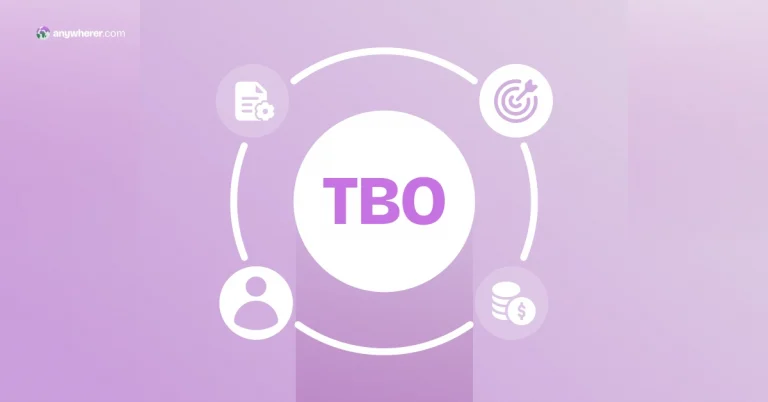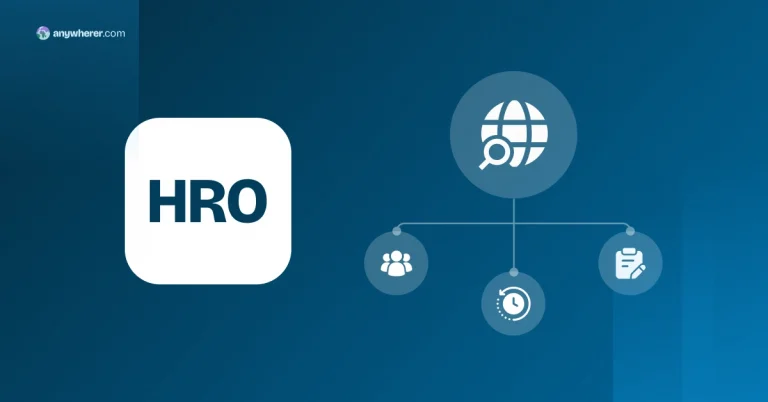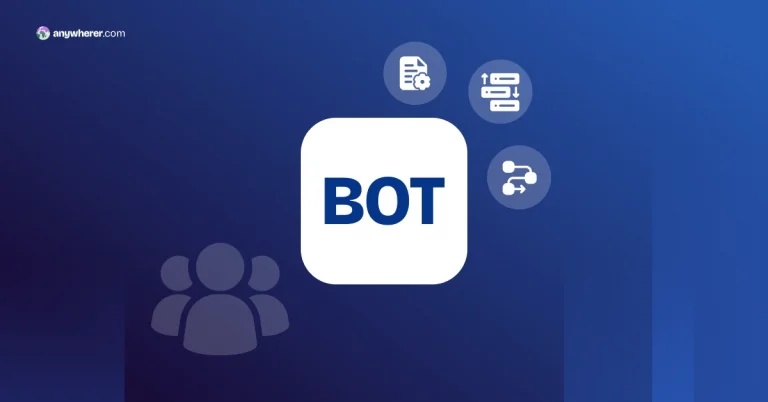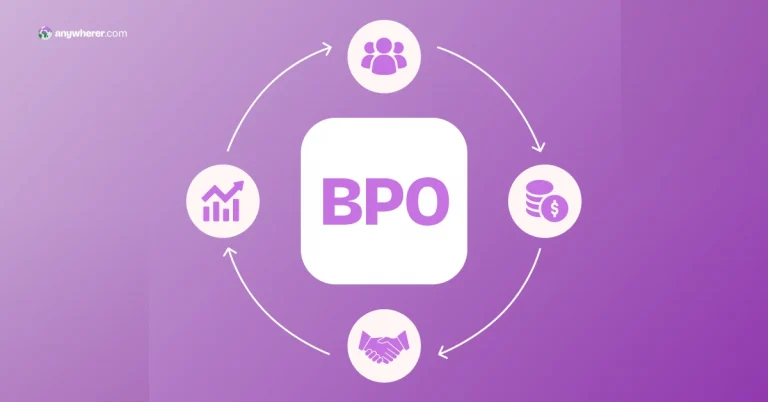Remote work isn’t just a trend anymore, it’s how the world gets things done. With more people working from anywhere (28% globally as of 2023, up from just 20% in 2020), companies now have access to a wider talent pool than ever before. But while hiring globally is exciting, managing remote teams? That’s where things can get tricky.
That’s when the Virtual Team Model (VTM) becomes valuable. It is a flexible framework that helps teams stay connected and productive across different time zones, locations, and cultures. In this post, we’ll unpack the VTM meaning, look at its pros and cons and share some real-world tips for making it work.
What Is VTM (Virtual Team Model)?
VTM acronym refers to virtual team model, a standard organizational structure for businesses that want to support their operations through remote collaboration. It requires the use of technology for seamless collaboration and communication. Project management tools, video conferencing software and other digital tools are utilised under this model to bring together teams working remotely from different parts of the world.
As remote work becomes the norm, businesses turn to global recruitment with complete remote operational models. In fact, the percentage of in-office job postings decreased from 83% to 68% in 2023 and this trend persisted throughout 2024 until the rate reached 61%.
VTM Definition
VTM acronym stands for virtual team model, a framework that enables organizations to collaborate seamlessly across different locations, time zones, and cultures.
Why do organizations use virtual teams? One key reason is that it allows businesses to quickly scale their workforce up or down depending on project needs. Although the virtual team model meaning fits ideally for businesses looking to expand their workforce internationally, it’s also a good approach for companies that want to minimize the overhead costs associated with maintaining a full-time, in-office workforce. Companies utilizing virtual teams can expect to save on salaries. Hiring talent from countries where wages are more competitive enables businesses to find highly skilled professionals without exceeding their recruitment budget. They can also save office rentals, equipment, and transportation costs.
Virtual Team vs Traditional Team Structures: Key Differences
The virtual team model differs from traditional team structures in many ways. Here are some of their key differences:
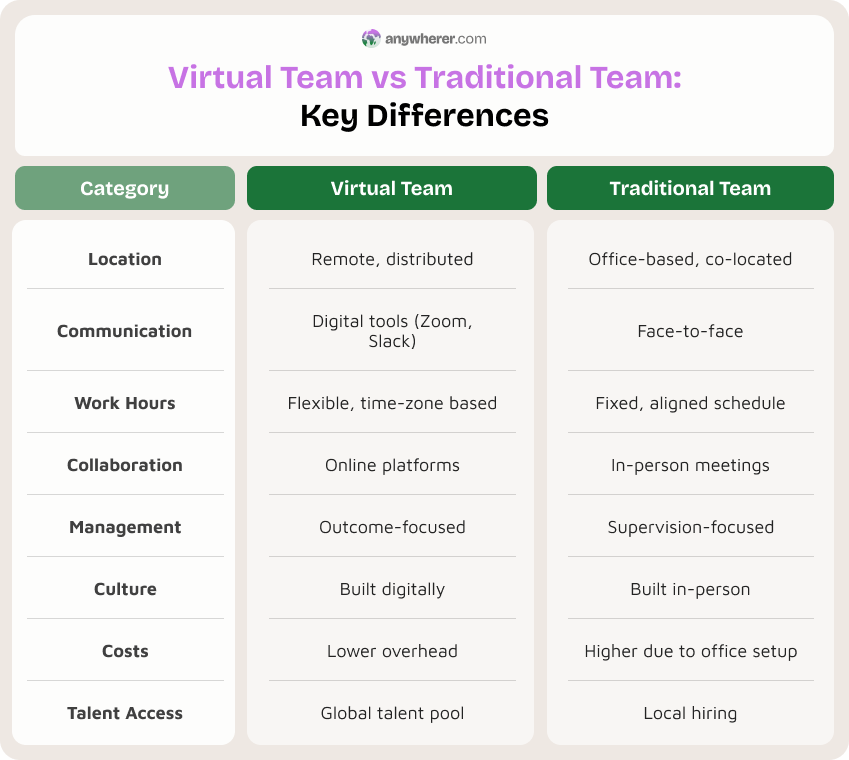
Work hours
While traditional teams have fixed 8-hour shifts, virtual global teams usually offer more flexibility when it comes to schedules. Remote employees are usually from varying locations and time zones, which means it can be difficult for virtual teams to establish a fixed working schedule. To address this, companies usually design core working hours – a specific time window when all members overlap for meetings and real-time discussions. Tasks are assigned and completed at different times, which allows for continuous workflow progression, even outside of traditional business hours.
Remote work culture
In traditional office settings, work culture is fostered through employees’ physical interactions. Communication happens daily when everyone is in the office to brainstorm ideas, discuss business strategies and cultivate a positive work culture. On the other hand, successful virtual teams rely on video conferencing, daily huddles, and employee rewards and recognition programs to establish a strong work culture in a remote environment.
Productivity
Whether office workers or remote employees are more productive has been an ongoing debate. A recent report reveals that remote workers are 35-40% more productive than office workers. This could be because of the flexibility afforded by remote workers, enabling them to finish tasks more efficiently. Unlike office workers in an 8-hour shift, remote workers tend to get more things done when given the freedom to work on projects on a schedule when they are most productive.
To maximize the virtual teams benefits, 65% of professionals consider it important to have instant messaging and video conferencing integrated into a single platform. This enhances workflow efficiency, reducing the need for multiple applications, and fosters a more connected and productive work environment for successful virtual teams.
Different Types of Virtual Teams
Virtual teams can look very different depending on what they’re set up to do, how long they’ll work together, and how closely members need to coordinate. Knowing the main types can help organizations choose the right team structure – whether it’s for solving problems, managing daily tasks, or handling urgent situations.
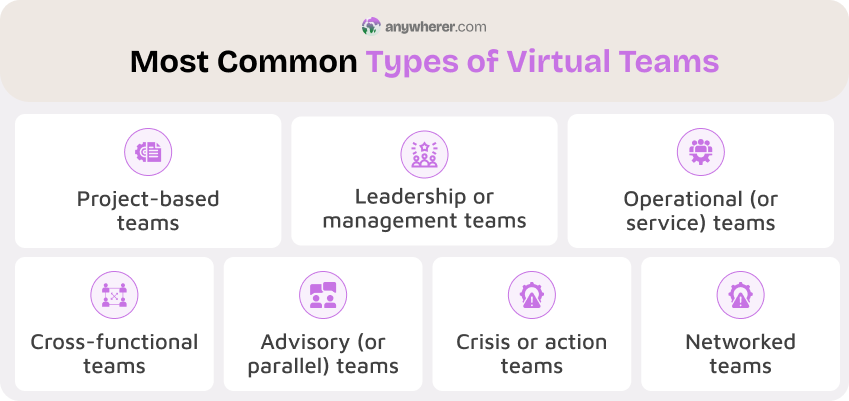
Here are the most common types of virtual teams:
- Project-based teams. Temporary teams created to finish a specific project within a defined time-frame. Example: A product development team hired to create a new software for a tech company.
- Leadership or management teams: Group of managers in charge of creating the company’s mission and vision and driving the strategic direction of the company. Example: Top executives responsible for the company’s corporate strategy.
- Operational (or service) teams: A virtual team example with employees tasked to handle the day-to-day workflow of a company, ensuring that business processes run smoothly and efficiently. Example: Customer service representatives who are focused on handling inquiries and delivering product value to customers.
- Cross-functional teams. A group of employees with diverse expertise and from different functional areas of the company. Example: Marketing, advertising, and sales teams all working together for a product launch.
- Advisory (or parallel) teams. Often hired on a temporary basis, this team is tasked with providing specialized expertise and advice. Example: A team of industry experts working to form sustainability strategies for a fast-fashion company.
- Crisis or action teams: A group of employees whose primary role is to address specific challenges or problems. Example: PR teams addressing a company’s issue and working on a better branding strategy.
- Networked teams: Project teams composed of members with varying skill levels and expertise. Example: IT teams collaborating on a specific global project.
Virtual teams aren’t one-size-fits-all and different industries use them in unique ways based on their goals and operations. Some of the sectors where the virtual team model is especially prominent include:
- Information Technology
- Marketing
- Advertising
- Customer support
- Consulting services
- Education sector
- E-Learning services
- and more.
How the Virtual Team Model Works
Understanding what is a virtual team is crucial for businesses to ensure productivity and collaboration in their remote work operations. Here’s how it works:
Roles and responsibilities
When building a virtual team, it’s crucial that each member gets assigned a clearly defined role. Tasks are often distributed based on expertise, ensuring efficiency in workflow execution. This also ensures that the team follows a structured hierarchy, making responsibilities transparent and accountability straightforward.
Collaboration tools
In making virtual teams work, employees rely on digital tools. This includes communication tools to facilitate daily check-ins or team meetings or project management software to manage tasks and track the team’s progress.
Time management
Since remote teams usually have varying schedules, companies implement various time management strategies, such as having an asynchronous workflow, where tasks are assigned with flexible deadlines, as well as establishing core business hours and overlapping schedules for real-time collaboration.
Performance monitoring
To make sure that goals are being met and tasks are completed on time, businesses track KPIs and regularly provide feedback to virtual team members. Regular feedback loops, goal-setting frameworks, and periodic performance reviews help ensure remote employees stay aligned with organizational objectives.
Cases When VTM Is a Perfect Fit
- You want access to top talents who are located beyond the local market.
- You need to hire local representatives without setting up physical offices.
- You want to cut office rent, utilities and transportation expenses.
- You mostly need freelance workers or project-based contractors.
- You want a faster way to onboard and manage remote employees efficiently.
Advantages of Virtual Teams
The virtual team model offers numerous advantages, making it an appealing choice for modern organizations. Here are some virtual teams benefits to take note of:
- Access to global talent. The basic virtual employee definition means skilled professionals working remotely from anywhere in the world. This allows businesses to find highly qualified candidates to join their organization. Understanding the TBO meaning (talent-based outsourcing) is essential here, as it focuses on hiring individuals based on their expertise rather than their location, ensuring companies get the best talent for their needs.
- Increased employee satisfaction and retention. Due to the flexibility that it provides, remote work has been an ideal choice among many employees. This helps companies retain talent for a much longer time compared to traditional office settings.
- Increased productivity and flexibility. Employees working in their most efficient hours means increased productivity for businesses under the VTM.
- Cost-savings. Since virtual teams mostly rely on digital tools, VTM serves as a cost-efficient solution for businesses that want to save on costs associated with equipment and office space rentals.

Challenges in VTM and Solutions to Overcome Them
Here are some challenges in working with virtual teams and ways to overcome them:
Challenge 1: Communication
One of the hardest things in managing virtual teams is facilitating effective communication within the team. Communicating via emails, chat messages and video conferencing is not always as reliable as talking to and meeting with your employees in person.
Solution: Digital communication tools can help in enhancing communication for virtual teams. According to a recent report, 65% of professionals consider it important to have instant messaging and video conferencing integrated into a single platform.
Challenge 2: Time management
When you define virtual team model, it means employees are located in various parts of the world. This makes coordinating meetings and project deadlines much more difficult.
Solution: Scheduling tools can help businesses find overlapping working hours. Rotating meeting times ensures that all team members’ schedules can be accommodated fairly.
Challenge 3: Technology issues
Not every remote employee has access to good equipment and high-quality internet connection. Depending on where they’re from employees might experience technology issues, which can disrupt day-to-day workflows.
Solution: Provide equipment such as laptops, webcams and other supplies to make sure that virtual teams have access to industry-standard digital tools. Make IT support available for all employees to ensure data security.
How to Manage a Virtual Team
Below are some of the best practices for managing virtual teams to ensure productivity, collaboration, and employee engagement.
Define roles and responsibilities
Virtual team members must have a clear set of roles and responsibilities. This helps ensure accountability for each team member and reduces confusion. By outlining expectations, tasks can be completed much faster and without any delays.
Enhance collaboration
The secret to a successful virtual team is effective collaboration. Although remote employees tend to work independently, companies must assert the importance of each member’s contribution to completing projects and meeting goals.
Build trust
Having regular meetings bridges communication gaps; in turn, it fosters more loyal and trustworthy virtual teams. The more that employees build a rapport with their teams, the more they are likely to develop trust in their company and become more motivated.
Establish workflows
To make sure that virtual teams are working towards a common goal, provide employees with a streamlined workflow that they can easily follow. Since working virtually can be more flexible, establishing a workflow can help employees stay on track and work more efficiently.
Virtual Team Model: What the Future Holds
The virtual team model is clearly not going away any time soon, especially as remote work becomes the norm for many global businesses. Here are some key developments that will define virtual team in the years to come:
- Increased demand for collaboration tools
As more companies turn to building virtual teams to establish their global presence, they will rely more on digital collaboration tools. As a result, the collaboration software market is expecting a significant growth in the future. In fact, reports say that it is projected to reach USD 62.4 billion by 2032, growing at a CAGR of 10.3% from 2024 to 2032.
- Role of AI in VTM
AI is continuously reshaping and redefining the virtual team meaning. With 41% of business leaders already planning to redesign their operations from the ground up using AI, this technology is expected to bring value by automating repetitive tasks, improving workflow efficiency, and facilitating smart decision-making.
- Global talent expansion
As employers struggle to find the skilled talent they need, VTM emerges as an ideal solution that allows companies to overcome local talent shortages. By hiring skilled professionals from different locations, businesses can tap into a global talent pool, ensuring they find the expertise required to stay competitive. This just means that VTM is here to stay, and remote work will ultimately become the norm to address job shortages.
Final Words on the Virtual Team Model
In today’s fast-moving business world, staying competitive means adapting to remote work trends. The Virtual Team Model is essential for managing virtual teams effectively. So, if you’re wondering what does VTM stand for, understanding it can help businesses set up efficient workflows and keep employees engaged.
VTM is a powerful tool that allows companies to break free from local markets and traditional office spaces. With the help of digital tools, businesses can unlock the full potential of their virtual teams and really excel in today’s world of work. As more companies adopt this model, it’s clear that the future of work will depend on how well virtual teams collaborate, innovate, and create success, no matter where they’re located.
What Are Virtual Teams: FAQs
How can businesses ensure productivity in virtual teams?
To make sure that virtual teams remain productive, it’s important to clearly define goals, facilitate effective communication, and choose the right collaboration tools.
What are the best tools for managing virtual teams?
Here are some of the best tools for virtual team management:
- Communication tools: Slack, Google Meet, Microsoft Teams, Zoom, WhatsApp.
- Project management software: Asana, ClickUp, Trello, Monday.com.
- File sharing and collaboration tools: Google Workspace, Notion, Dropbox.
How can companies build a strong culture within a virtual team?
Regular virtual meetings, casual check-ins, and online team-building events help create connections and establish a positive work culture. Defining company values and aligning them with daily interactions ensures a sense of belonging and purpose among remote employees.
What are the best practices for hiring and onboarding remote employees in a virtual team?
The best practices for hiring and onboarding remote employees include the following steps:
- Conduct regular check-ins and schedule frequent touchpoints to ensure engagement.
- Define roles and expectations upfront.
- Follow a structured hiring process with video interviews and skill assessments for potential candidates.
- During onboarding, provide digital welcome kits and mentor support.
- Facilitate employee training sessions using LMS platforms and assign clear tasks through project management tools.
Explore the virtual team model and optimize your remote workforce management.

Yaryna is our lead writer with over 8 years of experience in crafting clear, compelling, and insightful content. Specializing in global employment and EOR solutions, she simplifies complex concepts to help businesses expand their remote teams with confidence. With a strong background working alongside diverse product and software teams, Yaryna brings a tech-savvy perspective to her writing, delivering both in-depth analysis and valuable insights.

